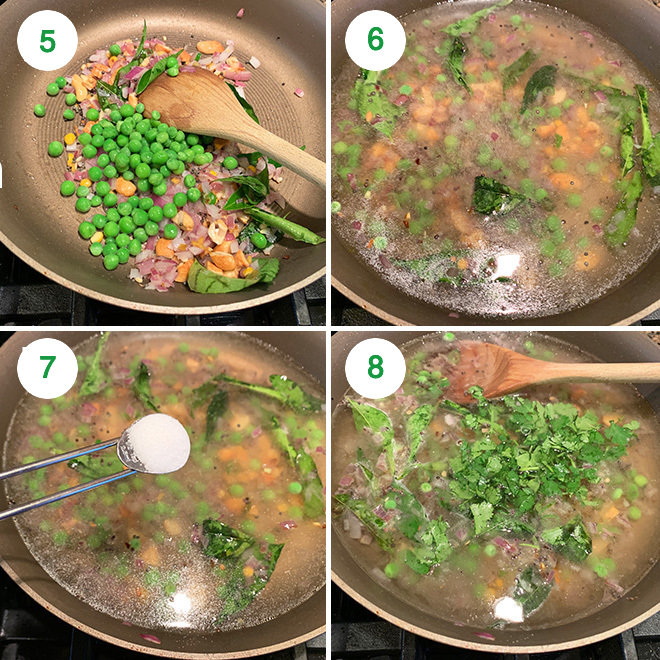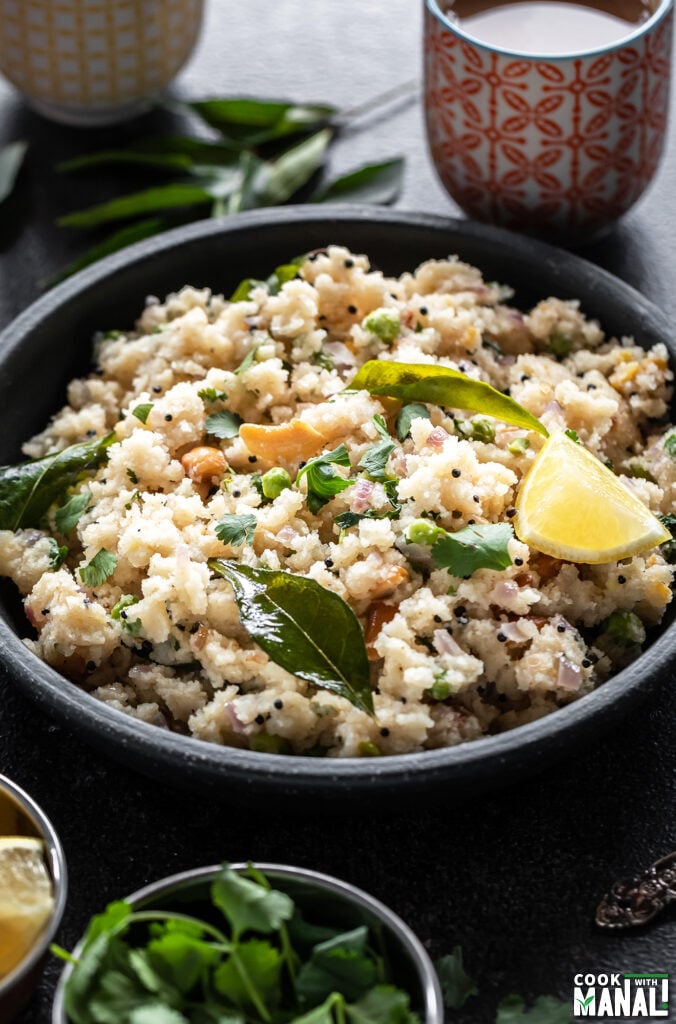Upma Recipe (How to Make Rava Upma)
Popular Indian breakfast Upma is a savory porridge made with semolina, water and veggies. It's a filling and nutritious meal and tastes great with a side of coconut chutney.
This post may contain affiliate links. Please read our disclosure policy.
One of the most common Indian breakfast, Rava Upma or simply Upma is a savory porridge made with semolina and veggies. It makes a filling and satisfying meal, especially with a side of chai or filter coffee! This is one of my go to breakfast recipes, you can easily make it vegan by skipping the ghee at the end.

Breakfast blues! I am sure I am not the only one who faces it. On most working days, my breakfast is a simple avocado toast or my favorite banana oatmeal. They are quick, easy and filling. Two of my other favorite breakfasts that I make often (and they are both Indian breakfast recipes) are Poha and Upma. They are both filling, hearty and delicious.
Table of contents
What is Upma?
Upma is a traditional Indian breakfast made with sooji (also called rava in the south). It’s more common in South India but now I see it just as much everywhere in India. The most common type of upma is made with rava (also known as sooji), but there are other varieties of upma too like semiya upma, bread upma, oats upma and more.
My mom always said, upma is the savory version of sooji halwa, which is true in a way. They are both made with sooji and water. The difference is one has sugar and the other has veggies and salt.
Rava Upma is often served with coconut chutney and filter coffee. I mostly eat it as much but of course the addition of chutney (& filter coffee!) makes it even more appetizing. I grew up eating upma for my breakfast. It was made at least once a week in my home and we used to eat it with ketchup! Now, I prefer it with coconut chutney.
Anyway though I grew up eating it, I was never a huge fan. Of course I ate it happily but it was not something I would crave for. But now, I really like it. In fact now, it’s one of my favorite things to make for breakfast.
Ingredients

Sooji/Rava: to make upma, we use semolina which is also known as sooji/suji or rava. There are 2 types of sooji available in the market- the coarse variety and the fine variety (which I used in making Raj Kachori). For making upma, we typically use the coarse variety.
Seasonings: upma is seasoned with whole spices like mustard seeds, lentils like chana dal and urad dal and also with fresh ginger and curry leaves.
Cashews: this is optional but I like adding cashews to my upma for some crunch.
Getting the Water to Sooji Ratio Right For Upma
Making upma is easy but I did struggle with getting the texture right for a while. Most of the time my upma turned out super dry. Basically it just never seemed like the one I would eat at South Indian restaurants and cafes.
After a lot of attempts, I realized that it all lies in using the right sooji to water ratio. From what I learnt, almost everyone told me to use a 1:2 ratio for sooji to water. However it never worked for me. I wanted my upma to be soft and melt-in-mouth kind and for that this ratio didn’t work.
What worked was a ratio of 1:3. So for every 1 cup of sooji, I add 3 cups of water and it works perfectly well.
How To Make Rava Upma
1- Roast 1 cup sooji/rava on medium heat until fragrant, around 5 to 6 minutes, stirring continuously. Sooji shouldn’t turn brown from the bottom so be careful. Remove sooji from the pan and transfer it to another bowl.
You can do this step of roasting sooji in advance and save time for busy mornings.
2- To the same pan now add 1& 1/2 tablespoons oil on medium heat. Add 1 teaspoon mustard seeds and let them pop.
3-Then add the following:
- pinch of hing
- 7 to 8 cashew nuts (raw),
- 1 teaspoon chana dal ((soaked in water for 10 mins before)
- 1 teaspoon urad dal (soaked in water for 10 mins before)
- 1 teaspoon finely chopped ginger
Sauté for 1 minute until they start changing color.
4- Add 1 small red onion (finely chopped), 1 chopped green chili and around 12 curry leaves. Cook for 2 minutes until the onions are soft.

5- Then add 3 tablespoons of green peas and stir (I used frozen peas and soaked them in warm water for 10 mins before adding them to the pan). Cook for 2 minutes until the raw smell of peas goes away.
6- Add 3 cups (24 oz) of water.
7- Then add 3/4 teaspoon salt (or to taste) to the water.
8- Also add 1 tablespoon chopped cilantro.

9- Add 1 teaspoon lemon juice and mix it well. You may also add sugar if you like a little sweet taste in your upma. You may add 1/2 teaspoon sugar. I did not add any.
10- Now let the water come to a boil.
11- Once the water comes to a boil, start adding the roasted sooji a little at a time.
12- Mix sooji after each addition in one direction with a wooden spatula.

13- Add all the sooji in a similar way, little by little until all of it is absorbed by water.
14- Then cover the pan with a lid and set the heat to low. Let it remain like that for 2 mins.
15- Remove the lid and add 1 teaspoon of ghee. This is optional but recommended. Turn off the heat.
16- Mix the ghee and close the lid again for a few seconds. Remove the lid, fluff upma with a fork. Serve upma warm with a side of peanut chutney or cilantro coconut chutney!

Make Ahead Options For Upma
Upma tastes best when freshly made and so I highly recommend making it and eating it fresh. However, there are few things which you can do to make it easier for you to make upma when you want it and the most important thing is to roast your sooji beforehand and keep it ready.
Having pre-roasted sooji saves 5 to 6 minutes of time on busy mornings. Leftover upma can be reheated in a microwave or in a pan. You might need to sprinkle a little water when reheating in a pan. I also use a potato masher when reheating in a pan to bring everything together as upma usually clumps up as it cools.
Manali’s Expert Tips
After making upma for years, here is what I have learned which helps me in making good upma at home.
- Use 3 cups of water for 1 cup of sooji: this results in a soft consistency like you get in restaurants. I have tried 2 and 2 & 1/2 cups, but I think 3 cups works best.
- Use ghee and oil more freely for this upma recipe: I have used 1& 1/2 tablespoons oil, you may use even more for a softer and tastier upma. I also add a teaspoon of ghee in end to enhance the flavors. It is optional but I recommend adding a little ghee for extra flavor.
- Add more veggies for more flavor in your upma: I added only peas, You can add peppers, carrots. My mother-in-law also adds cauliflower (cut into very small pieces) and it tastes good.
- Don’t add all the sooji in one go: Add 1 to 2 tablespoons at a time, stirring after each addition. This way the upma will not form any lumps.
- Don’t forget the lemon juice: a squeeze of fresh lemon juice really helps in bringing out the flavors so don’t skip on that.
- And finally, serve the upma straight away when warm. It tastes best when fresh. The final texture of upma also depends on the type of sooji that you use for the upma. So if you are not happy with the texture even after following all these steps, try going for a different brand of sooji.

Different Upma Recipes
If you want to try some different Upma recipes which aren’t as traditional, try Quinoa Upma where sooji is replaced with quinoa making it more protein packed and also gluten-free. There’s also Bread Upma which is an easy and quick version made with bread. It’s a great way to use leftover bread.
This post has been updated from the recipe archives, first published in January 2019.
Upma Recipe (How to Make Rava Upma)

Ingredients
- 1 cup sooji/rava semolina, 182 grams
- 1 & 1/2 tablespoons oil or can use ghee, I used avocado oil
- 1 teaspoon mustard seeds
- generous pinch of hing also known as asafetida
- 7-8 raw cashews broken
- 1 teaspoon chana dal soaked in water for 10 mins
- 1 teaspoon urad dal dhuli soaked in water for 10 mins
- 1 teaspoon chopped ginger
- 1 small red onion chopped, around 70 grams
- 1 green chili chopped, or to taste
- 12 curry leaves
- 3 tablespoons green peas frozen
- 3 cups water 24 oz
- 3/4 teaspoon salt or to taste
- 1 tablespoon chopped cilantro + more to garnish
- 1 teaspoon lemon juice
- 1 teaspoon ghee
- lemon wedges to serve
Instructions
- Start by roating the sooji on medium heat in a pan for around 5 to 6 minutes until it is fragrant. Be careful not to burn it, so stir continuously while roasting. Then remove the roasted sooji in a bowl or plate.
- Now, to the same pan add the oil on medium heat and then add the mustard seeds and let them pop. Once the mustard seeds pop, add the hing, cashews, chana and urad dal and ginger. Sauté for 1 minute until they become light golden or start changing color.
- Then add the chopped onion, green chili and the curry leaves. Cook for 2 to 3 minutes until the onions are soft and translucent.
- Add the green peas (I used frozen green peas which were soaked in warm water for 10 minutes and when use in the recipe.) Cook the peas for around 2 minutes until the raw smell goes away.
- Now, add 3 cups of water and stir. Add the salt, cilantro and lemon juice and stir to combined. You may also add 1/2 teaspoon sugar at this point if you like, I did not add any. Let the water come to a boil.
- Once the water starts boiling, start adding the roasted sooji, little at a time. Mix sooji after each addition in one direction with a wooden spatula. This will minimize lump formation. Add all the sooji in similar way, little by little until all of it is absorbed by water.
- Once all the sooji has been added, cover the the pan with a lid and set heat to low. Let it remain like that for 2 mins.
- After 2 minutes, turn off the heat and open the lid. Add 1 teaspoon ghee (optional but recommended) . Mix the ghee with everything else and cover the pan with the lid again and let it stay like that for 1 more minute. Now, open the lid and fluff the upma with a fork.
- Serve upma hot with a cup of chai and a side of coconut chutney and lemon wedge.
Video
Notes
- Skip the ghee at the end to keep this upma recipe vegan.
- Use a water to sooji ratio of 3:1 for to the best upma consistency.
- Use vegetables like onions, carrots, cauliflower, green peas etc. for more flavor in your upma.
- Don’t skip the cashews, they add a really nice crunch to the upma.
Nutrition
Nutrition information is automatically calculated, so should only be used as an approximation.














worked well for me, others have suggested peanuts so I may try that next time.
This Upma recipe is a keeper! Super easy to make and healthy as well. Thanks for sharing! 🙂
I first made Upma a few weeks ago. Your recipe is excellent! You are concise and accurate and it makes trying a new recipe a joy. It was delicious and now I make it every weekend.
Thanks Jen!
Hi Manali. Is there a way to make this recipe gluten free?
you can replace rava with quinoa https://www.cookwithmanali.com/quinoa-upma/
I have made upma with rice rava before. Or try a gf cream of wheat.
Finally my daughter learnt how to make good upma. Very good.
glad to hear!
I add a tablespoon of sour yogurt alongwith the water and it tastes amazing
Finally I am able to make UPMA according to your well explained recipe. Thanks Manali Ji.
welcome!
hi!! is this 240 calories for 3 cups total or for one cup serving?
single serving, having said that this is calculated automatically by a plugin so just an estimate
Good
Thank you for the great recipe. Tried it this way and turned out really well 🙂
glad to know!
Dear Ms. Manali,
Thanks to your clear instructions, I finally made good upma. Wishes from afar. Philly, PA
Thank you so much for sharing the recipe. I’ve been trying to look for the best Upma recipe and I’m glad I came across your page. The upma turned out amazing and was so delicious.
awesome, glad to know!
Very nice recipe with every possible aspect properly explained. My upma would sometimes become mushy and so I fear making upma for breakfast, but with your recipe i finally got the perfect texture. Thanks a lot??
so glad! 🙂
Amazing recipe.. good taste, great smell, and looked appealing too..
This morning we tried our first attempt at upma using your recipe. It came out very nicely and delicious. Thank you for sharing your recipe.
I tried the Upma with your recipe and it’s really really delicious. Thanks
welcome!
Today tried the upma for first time. It was good. Thanks for the tips.
Iam a Tamilian. Turned out the way my Mom used to make it . Wow!
awesome! 🙂
Doyou have the recipe for coconut chutney?
yes https://www.cookwithmanali.com/coconut-chutney/
Very well described recipe. Would love to make it. Can u please tell how much salt do u normally add in this recipe?
it’s mentioned in the recipe – 3/4 teaspoon salt, or to taste
I tried it in home. Really delicious, Thank you
welcome!
This is so good! It’s been years since I’ve had upma. The store was out of curry leaves so I had to leave them out but the dish was still really great.
Thanks for the recipe!
you are welcome! next time try with curry leaves, even better 🙂
Thanks Angie! It’s very good!